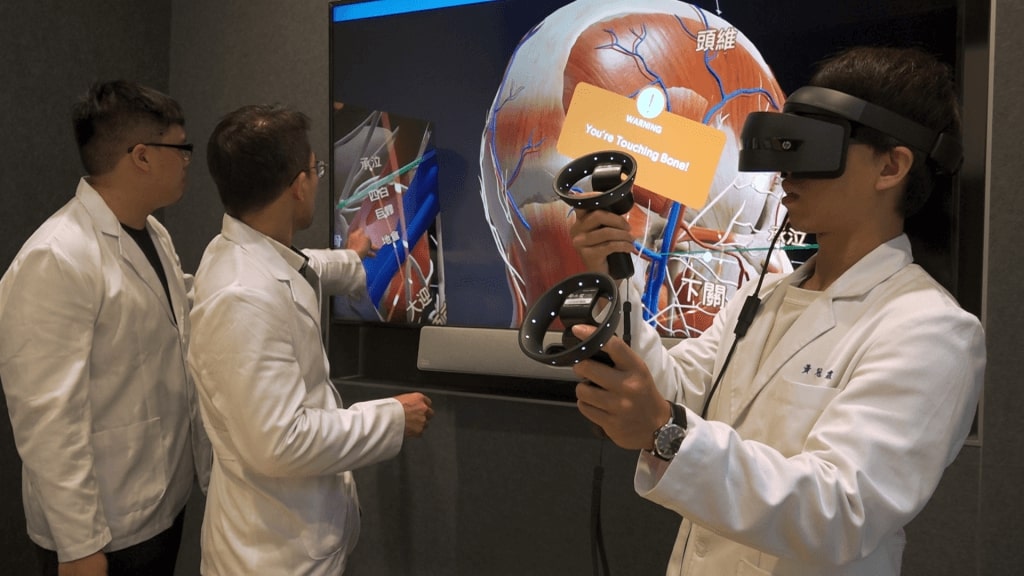VR in Medicine

Virtual reality (VR) has witnessed significant growth since the all-time best-selling game Beat Saber became popular in 2018 and Facebook (Oculus) changed its company name to Meta in 2021. VR technology is changing our lives, not only the way we socialize, the way we work, but also the way we receive treatment and education.
In this article, we will take a look at virtual reality used in medicine, more specifically how it helps doctors and future doctors.
Virtual Reality for Medicine
Virtual reality (VR) is often seen as a toy for people to play video games, watch videos, and immerse themselves in a virtual world of social networking. But it can also be used to help doctors to better treat patients, and also future doctors to better prepare themselves.
VR technology is already transforming patient treatment and medical education, especially since the COVID-19 pandemic. With social distancing in effect and expensive cadavers in shortage, it not only helps doctors interact and engage patients whenever, and wherever they feel most comfortable, but it also allows students to learn and understand the human body, practice, and develop the skills they need to perform real-life surgeries.
Virtual Reality Medicine Education
Today, VR technology is reshaping medical institutions—such as hospitals and schools—by taking cadavers and classrooms out of the equation. It is helping medical practitioners relieve their patients’ pain, and also medical students acquire knowledge and apply it to practice in a new, revolutionized way.
In the near future, treatment, simulation, and learning will no longer be limited by geography. The ability to help and engage patients, dissect human bodies, and learn human anatomy with multiple instructors or learners in a virtual environment may become part of the curricula and mainstream of virtual reality in medical field and education.
Virtual Reality in Medical Pain Management
In recent years, pain control has taken a step further with VR.
There are many optionsfor pain reliefs, including medication, physical therapy, and acupuncture. Take acupuncture for example. Traditionally, it can help relieve both acute and chronic pain even on battlefields, where space, resources, and supplies are limited.
The US military has already used acupuncture for pain management, with its acupuncturists relieving patients’ stress and pain through needling acupoints, according to a news release published by the United States Air Force Medical Service.
Acupuncture then combined with virtual reality can further help reduce pain in not just adults, but also children.
Hospitals implementing VR technology have already helped children who are either suffering from pain or fearful of needles.
A study from the National Library of Medicine (NLM) has reported that 106 children undergoing circumcision were divided equally into 2 groups, where the control group received routine nursing care, while the intervention group acupoint treatment integrated with VR technology. The results showed that the latter group had a lower pain score and higher satisfaction rate.
We can conclude that acupuncture solution combined with VR has helped relieve the anxiety of the children, distracted their attention, increased their pain threshold, and improved the satisfaction among patients and their families.
Another Stanford study has also pointed out a VR technology was beneficial in relieving anxiety and lifting the fear of children. In the nationally ranked, VR-equipped Lucile Packard Children’s Hospital Stanford, before a needle poke or surgical procedure, kids can wear VR goggles and immerse themselves in VR to increase their level of distraction.

VR in the Medical Field
VR technology not only assists doctors with relieving patients’ pain and fear, but it also helps “future” doctors, namely medical students, accumulate their medical knowledge and sharpen their skills easily, and later apply them in the real world.
Some of the benefits of learning in VR include:
- Visualization of the interior of the human body. The study of human anatomy in VR from multiple angles is essentially a biology 101 class for every medical student. They can literally go inside a beating heart and watch the blood flows within the heart.
- Real-life surgical procedures. Medical students can “operate” in a VR environment with high-quality, medically accurate images reconstructed based on MRI and CT scans. Each student will receive instant, haptic feedback for every action performed as if it is taking place in real life, and learn from their mistakes.
- Fewer resources are needed. The dissection of expensive cadavers—which can cost between USD 2,000 to USD 3,000 each whole dead body—is a norm for every medical student. But now, it can be carried out in a virtual space repeatedly, at any time, with a VR anatomy solution which cost less.
Virtual Reality in Medical Field for Physical Therapy and Rehabilitation
Nowadays, VR is incorporated into doctors’ practice to improve patients’ coordination and balance during physical therapy.
Let’s say you are experiencing shoulder pain. You may enjoy a session with your physical therapist (PT) while wearing a VR headset. Inside the headset, you may be required to watch a video and under its instructions, perform actions such as reaching over your head.
Or, you may have a balance problem after injuring your knee. With the help of VR, your PT can create various contents that engage, entertain and challenge you in order for you to improve your movement and strength—things that are more difficult to achieve in the real world.
By integrating with VR technology, it is easier for patients to stay focused and engaged in their rehabilitation process. It also increases the ease, acceptability, and effectiveness of treatment for anxiety, one of the most common mental disorders affecting about 30% of U.S. adults, according to The National Institute of Mental Health (NIMH).
Therapists can use VR to improve:
- Pain relief from for example your shoulder, back, and neck pain
- Your upper and lower extremity coordination
- The balance of your body from knee or hip surgery, especially in the first days which are the most important stage for early treatment
- The proper head or eye movements to help you stay upright
In 2019, another NLM study compared VR medical use in rehabilitation versus conventional physical therapy to improve balance and gait in patients with Parkinson’s Disease. The results showed that the group which received VR therapy had higher scores on balance and mobility (Berg Balance Scale, short for BBS), and the time needed to stand up to walk (Timed Up and Go Test, short for TUGT).
We can conclude that applying VR in healthcare has shortened the patients’ recovery time, making it easier for them to do exercises.
Overall, VR for patients provides an alternative way to relieve stress and distract their attention away from their pain, and motivate and encourage them to finish their exercises in physical therapy or rehabilitation
Future of VR in Medical
Today, we see medical VR technology being used in areas such as pain management, therapy, rehabilitation, education, and training. In the near future, we may be addressing other areas such as preventive healthcare, assistive living, cancer therapy, and surgical training.
According to a report by Fortune Business Insights, the VR market in medicine will grow from USD 628 million in 2022 to USD 6.2 billion by 2029.
So what is the role of VR for medical use in the following years? What is more to VR, a technology that has been proven to be more than a buzzword for gaming, but also a powerful tool that improves medical treatment and education for doctors, instructors, and students worldwide?
It is believed that virtual reality in medicine will become widely adopted, and even an “actual” reality.
VR technology will continue to help hospitals in resolving phobias and fears, and schools in surgery simulations with real-life-like experiences at a much lower cost. On top of that, there is also a great potential we will be booking in-person doctor appointments, meeting with therapists in a virtual reality room for exercises, or dissecting human bodies countless time in a virtual classroom.